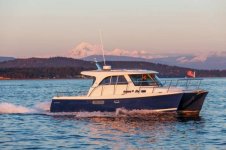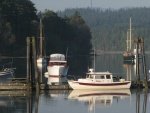kevin ware
New member
Earlier this year we sold the TomCat we had owned for the past 8 years and replaced it with an Aspen 32 catamaran (actually a "proa"). On announcing that on the website several readers asked that given we were such long time TC owners, we provide some description of the differences, and what we think about them.
The Aspens is a good 7 feet longer and 10 feet wide, but oddly nearly the same weight as the Tom Cat. It has a lot more freeboard than the TC, particularly in the stern. The TC was a planing cat., the Aspen a displacement one, and the difference in ride is quite noticeable. The TC tended to pound when on the plane in a 2 foot chop, or when encountering some large boat wake, the Aspen just slices through it.
The Aspen came with a trailer, and at 36 feet overall in length you would think it harder to tow around than the TC. But to our surprise we found that not to be the case. Due to its width, you do need a 'wide load' sign with the Aspen, but our 1 ton Ford X350 actually handled the larger boat easier than the smaller one. We think that may have something to do with the lower tongue weight on the Aspen, and the fact the boat itself seems to be more streamlined.
There is a fair loss of speed with the Aspen vs the TC. We have found it does a good 18 knots burning about 7.5 GPH of diesel, vs 23-24 knots at 12 - 13 GPH of gas in the TC. For a typical 2 hour trip, the slower speed requires an extra 20 minutes or so in the Aspen.
Oddly, we find the Aspen with its single engine Volvo diesel located on the SB side easier to maneuver in tight quarters than the SD, with its twin Honda 150s. Differential power with the Hondas made for pretty good maneuverability, but they do not compare with bow and stern thrusters in the Aspen.
The difference in interior space is obvious, but mostly noticiable on the aft deck and bathroom/shower area. The bed on both is in the bow, and of similar size, not much difference between the boats once in there. The galley is better laid out in the Aspen, and the properly installed propane stove much easier to operate that the old Wallas in the TC.
Another nice feature is the hot frsh water continuously available from the Aspens cngiens cooling system, and is a forced air furnace that pushes air everywhere in the boat.
Finally, the Aspens navionics and autopilot is 2 years old (2017), whereas the TCs were 12 years old. Big difference in how the autopilot in particular handles the boat. The newer autopilot has the boat on a rail, whereas the earlier one tended to wander a bit.
Overall we are very happy with the change, but given the Aspen cost more than 3 times the amount of our TC, one would expect that.
For the money, a TC in good shape, is a hard boat to beat. Ours was a 2006, in very good condition, had about 500 hours on the Honda 150s, and we sold it for just under $89,500 to the first caller following our ad in C-Brats. We subsequently had 4 additional offers to purchase, some willing to pay more than we had listed it for. We decided good clean TCs must be hard to find.
KW
El Gato Tomas (CD TC)
O'Kari (Aspen 32)
The Aspens is a good 7 feet longer and 10 feet wide, but oddly nearly the same weight as the Tom Cat. It has a lot more freeboard than the TC, particularly in the stern. The TC was a planing cat., the Aspen a displacement one, and the difference in ride is quite noticeable. The TC tended to pound when on the plane in a 2 foot chop, or when encountering some large boat wake, the Aspen just slices through it.
The Aspen came with a trailer, and at 36 feet overall in length you would think it harder to tow around than the TC. But to our surprise we found that not to be the case. Due to its width, you do need a 'wide load' sign with the Aspen, but our 1 ton Ford X350 actually handled the larger boat easier than the smaller one. We think that may have something to do with the lower tongue weight on the Aspen, and the fact the boat itself seems to be more streamlined.
There is a fair loss of speed with the Aspen vs the TC. We have found it does a good 18 knots burning about 7.5 GPH of diesel, vs 23-24 knots at 12 - 13 GPH of gas in the TC. For a typical 2 hour trip, the slower speed requires an extra 20 minutes or so in the Aspen.
Oddly, we find the Aspen with its single engine Volvo diesel located on the SB side easier to maneuver in tight quarters than the SD, with its twin Honda 150s. Differential power with the Hondas made for pretty good maneuverability, but they do not compare with bow and stern thrusters in the Aspen.
The difference in interior space is obvious, but mostly noticiable on the aft deck and bathroom/shower area. The bed on both is in the bow, and of similar size, not much difference between the boats once in there. The galley is better laid out in the Aspen, and the properly installed propane stove much easier to operate that the old Wallas in the TC.
Another nice feature is the hot frsh water continuously available from the Aspens cngiens cooling system, and is a forced air furnace that pushes air everywhere in the boat.
Finally, the Aspens navionics and autopilot is 2 years old (2017), whereas the TCs were 12 years old. Big difference in how the autopilot in particular handles the boat. The newer autopilot has the boat on a rail, whereas the earlier one tended to wander a bit.
Overall we are very happy with the change, but given the Aspen cost more than 3 times the amount of our TC, one would expect that.
For the money, a TC in good shape, is a hard boat to beat. Ours was a 2006, in very good condition, had about 500 hours on the Honda 150s, and we sold it for just under $89,500 to the first caller following our ad in C-Brats. We subsequently had 4 additional offers to purchase, some willing to pay more than we had listed it for. We decided good clean TCs must be hard to find.
KW
El Gato Tomas (CD TC)
O'Kari (Aspen 32)


